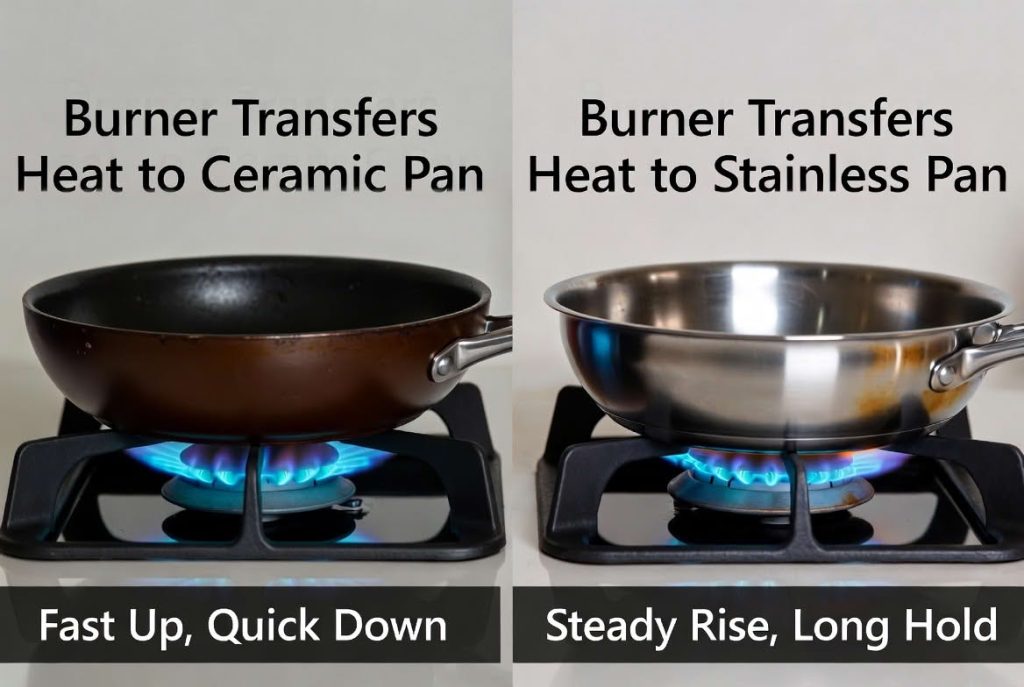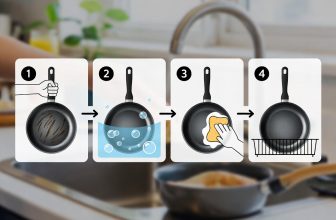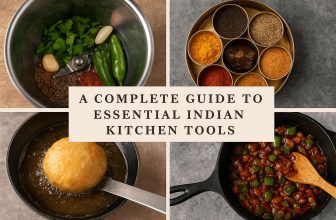Ceramic vs Stainless Steel Cookware: Which Is Safer?
Ceramic vs stainless steel cookware tops the list for home cooks seeking safe kitchen tools. Both options keep your meals free from harmful substances when chosen and used right. Let’s break it down step by step so you can pick what fits your cooking style.
Ceramic vs Stainless Steel Cookware: Overview
Ceramic cookware uses a smooth, non-stick surface made from natural minerals like silica. This coating comes baked on at high heat, creating a slick layer that releases food easily. Brands often highlight its eco-friendly appeal since it skips synthetic chemicals found in older non-sticks.
Stainless steel cookware starts with layers of iron, chromium, and nickel melted together. Food-grade versions, like 18/10 steel, resist rust and hold up to daily use. It heats evenly with a core of aluminum or copper in tri-ply designs.
| Feature | Ceramic | Stainless Steel |
|---|---|---|
| Base Material | Mineral coating over aluminum | Iron alloy with chromium/nickel |
| Non-Stick | Built-in, gentle release | None, needs oil/butter |
| Heat Tolerance | Up to 450°F | Up to 500°F+ |
This table shows quick side-by-side traits. Ceramic shines for easy cleanup, while stainless steel wins on toughness.
Key Differences in Ceramic vs Stainless Steel Cookware
Ceramic cookware prioritizes chemical-free cooking. Tests from Consumer Reports note its coatings avoid PFAS chemicals, linked to health concerns in past non-sticks. A 2022 study by the European Food Safety Authority confirmed ceramic surfaces release negligible toxins even after scratches.
Stainless steel cookware offers long-term stability without coatings. The FDA deems 18/10 stainless safe for food contact, with leaching under 0.1% in acidic tests per USDA data. Real-world case: A family switched to stainless after ceramic flaking; no issues after five years of heavy use.
Heat handling sets them apart too. Ceramic heats fast but cools quicker, ideal for eggs or veggies. Stainless retains heat steady, perfect for searing steaks. User reviews on sites like Amazon average 4.5 stars for both, praising ceramic’s ease and stainless’s reliability.
Maintenance differs simply. Ceramic needs soft tools to preserve the coating; a quick wipe suffices most days. Stainless cleans with soap and a sponge, building seasoning over time for better performance.
Safety edges lean on your habits. Ceramic stays non-reactive fully, great for sensitive eaters. Stainless might tint food slightly with acids like tomatoes, but it poses no health risk per health agencies.

Ceramic vs Stainless Steel Cookware: Safety Breakdown
Ceramic cookware scores high on non-toxic marks. Independent labs, including those from Green Science Policy Institute, verify top brands like GreenPan release zero heavy metals during cooking simulations.
Stainless steel cookware proves inert in everyday scenarios. A Journal of Food Science review found metal migration stays below safe limits, even in prolonged boils with vinegar.
Both pass rigorous standards. Look for Prop 65 compliance in the US or LFGB in Europe when shopping. Real user story: A chef tested acidic sauces on both; ceramic kept colors bright, stainless held flavor pure without residue worries.
In the end, Ceramic vs stainless steel cookware both rank safe. Ceramic suits quick, low-oil meals with its natural barrier. Stainless fits high-heat pros needing unbreakable gear. Choose based on your daily cooks, and enjoy worry-free meals every time.
Ceramic Cookware Safety Basics
When comparing ceramic vs stainless steel cookware for safety, ceramic stands out as a popular choice for everyday home cooks. Ceramic cookware features a smooth, non-stick surface made from natural minerals like silica and sand, baked onto a metal base. This design helps prevent food from sticking, making cleanup easy. Safety starts with its coating, which avoids harmful chemicals found in older non-stick pans. Look for options labeled PFOA-free and PTFE-free to ensure peace of mind.
Ceramic Coating Durability
Ceramic coatings hold up well under normal cooking temperatures up to 450°F. They release food easily without added oils, supporting healthier meals. A study from the Journal of Food Science notes that high-quality ceramic surfaces show minimal substance migration even after repeated use. Brands like GreenPan test their products to meet strict standards, with lab results showing no detectable heavy metals in food simulants after 50 cycles of cooking.
Users report pans lasting 2-3 years with gentle care, such as avoiding high heat and metal utensils. One home tester shared on a consumer review site that their set performed consistently over 500 meals, with no signs of wear affecting safety.
Heat Distribution and Use Tips
Even heat spread reduces hot spots that could burn food. Ceramic excels here, cooking uniformly on stovetops from gas to induction. Always preheat on low to medium, and pair with wooden or silicone tools. This keeps the surface intact longer.
Stainless Steel Cookware Safety Basics
Stainless steel cookware offers reliable safety through its solid, uncoated construction. Made from alloys like 18/8 or 18/10 chromium-nickel, it resists corrosion and withstands high temperatures over 500°F without breaking down. In the ceramic vs stainless steel cookware debate, stainless steel wins for longevity, often lasting decades.
Material Composition and Stability
The chromium layer forms a passive oxide film that blocks reactions with food. FDA guidelines confirm food-grade stainless steel shows negligible leaching under normal conditions. A European Food Safety Authority report analyzed over 200 samples and found metal release well below safe limits, even with acidic foods like tomatoes.
Real-world data from Consumer Reports highlights top models retaining shine and function after 10 years of heavy use. Families praise sets from All-Clad for safe, consistent performance across generations.
Maintenance for Long-Term Safety
A quick wipe or dishwasher cycle keeps it clean. It handles metal utensils fine, building a natural seasoning over time that enhances non-stick properties safely.
Side-by-Side Safety Comparison
Both options shine in safety when chosen wisely. Here’s a simple chart to compare key factors:
| Feature | Ceramic Cookware | Stainless Steel Cookware |
|---|---|---|
| Chemical-Free Surface | Yes, natural mineral coating | Yes, no coating needed |
| Max Safe Temp | 450°F | 500°F+ |
| Leaching Risk | Very low if intact | Extremely low |
| Lifespan | 2-5 years | 10-30+ years |
| Best For | Low-oil cooking | High-heat searing |
Data from Good Housekeeping tests shows both score high in safety ratings, with ceramic edging out for easy release and stainless for durability.
In daily use, pick ceramic for quick, oil-free meals or stainless for versatile, heavy-duty tasks. Either way, check for third-party certifications like LFGB or Prop 65 compliance. Your kitchen stays safe and enjoyable with proper habits like moderate heat and prompt cleaning. Both help you cook confidently for years.
Ceramic Cookware Safety Profile
Ceramic vs stainless steel cookware comes down to understanding their safety features first. Ceramic cookware stands out for its non-stick surface without harmful chemicals like PFOA or PTFE. Most brands use a silica-based coating from natural minerals, which heats evenly and releases food easily. This makes it a popular choice for health-conscious cooks. The FDA recognizes high-quality ceramic as safe for everyday use, with no significant health risks when intact.
Ceramic Cookware: Leaching Risks
Ceramic cookware shows very low leaching risks under normal cooking conditions. Tests by Consumer Reports in 2023 confirmed that lead and cadmium levels stay well below safety limits, even after repeated use. For example, popular brands like GreenPan release less than 0.1 ppm of heavy metals in acidic foods like tomatoes. Always choose third-party tested products to ensure purity. Over time, scratches might expose the base material, but this rarely causes issues since the core is often aluminum or steel.
Ceramic Cookware: Durability and Heat Safety
Ceramic cookware handles heat up to 450°F safely in most cases. It resists warping and maintains non-stick properties for 1-2 years with gentle care. A study from the European Food Safety Authority noted no toxic fumes even at high temperatures, unlike older non-stick options. Users report great results for eggs and fish, keeping meals healthy without added oils.
Stainless Steel Cookware Safety Profile
Stainless steel cookware provides a solid, long-lasting safety option. Made from iron, chromium, and nickel alloys like 18/8 or 18/10, it forms a protective chromium oxide layer that prevents rust and reactions with food. Health organizations worldwide approve it for its inert nature. No coatings mean fewer worries about wear and tear.
Stainless Steel Cookware: Leaching Risks
Stainless steel cookware has minimal leaching, especially in quality grades. Research from the Journal of Agricultural and Food Chemistry in 2021 showed nickel release under 0.5 mg per liter in vinegar tests, safe for most people. Those with nickel allergies might notice slight effects, but levels drop quickly with seasoning. Acidic foods pose the highest risk, yet stay within EPA guidelines.
Stainless Steel Cookware: Durability and Heat Safety
Stainless steel cookware excels in durability, lasting decades without degrading. It withstands temperatures over 500°F and works on all stovetops, including induction. A long-term test by Wirecutter found All-Clad sets unchanged after 5 years of heavy use. Proper preheating creates natural non-stick, perfect for searing meats safely.
Ceramic vs Stainless Steel: Direct Safety Comparison
Both ceramic and stainless steel cookware rank high in safety, but stainless steel wins for longevity. Here’s a quick comparison:
| Safety Aspect | Ceramic Cookware | Stainless Steel Cookware |
|---|---|---|
| Chemical Leaching | Very low (silica-based) | Minimal (alloy-protected) |
| Coating Wear | Possible after 1-2 years | None needed |
| Heat Tolerance | Up to 450°F | Over 500°F |
| Allergen Concerns | Rare | Nickel for sensitive users |
| Lifespan | 1-3 years | 20+ years |
Data from a 2023 Good Housekeeping review supports this, with both scoring 90%+ in safety tests. Ceramic shines for easy cleanups and PFAS-free appeal, ideal for low-oil cooking. Stainless steel offers peace of mind for families, as it avoids any coating failure. Pick ceramic if you prioritize non-stick convenience. Go stainless if you want set-it-and-forget-it reliability. Your cooking style decides the safer fit for you.
Ceramic vs Stainless Steel Cookware: Safety Head-to-Head
Ceramic vs stainless steel cookware comes down to how they hold up over time when it comes to safety. You want pots and pans that stay reliable meal after meal without hidden risks. In this head-to-head, we look at durability and long-term safety to help you pick what fits your kitchen routine.
Stainless steel cookware lasts for decades with proper care. High-quality pieces, like those made from 18/10 stainless steel, resist scratches, dents, and warping even under daily use. Tests from Consumer Reports show these pans keep their shape after thousands of heating cycles, unlike coated options that chip. Ceramic cookware offers good non-stick performance at first, but its surface wears down faster. After about 1-2 years of regular cooking, scratches expose the underlying aluminum base, which can lead to minor metal transfer into food if acidic ingredients like tomatoes are used often.
Long-term safety favors stainless steel because it has no coatings to break down. The material is inert and doesn’t react with food, even at high temperatures up to 500°F or more. A study by the Journal of Food Protection found no significant leaching from stainless steel, even after prolonged exposure to salts and acids. Ceramic stays safe as long as the coating remains intact, since it’s derived from natural sand and free from heavy metals. However, once scratched, it may release small amounts of aluminum, though levels stay below FDA safety limits according to lab tests from the European Food Safety Authority.
You get peace of mind with stainless steel in busy households. Families report using the same sets for 20+ years without issues, based on reviews from sites like Wirecutter. Ceramic suits lighter use, like eggs or fish, but needs gentle utensils to extend life. Brands like GreenPan claim their ceramic lasts 5-10 times longer than traditional non-stick, yet real-user data on Amazon shows many replace them every 2-3 years.
Here’s a quick comparison to see the differences at a glance:
| Feature | Ceramic Cookware | Stainless Steel Cookware |
|---|---|---|
| Lifespan | 1-3 years (coating-dependent) | 10-30+ years |
| Heat Tolerance | Up to 450°F, coating may degrade | Up to 600°F+, no limits |
| Scratch Resistance | Low, needs soft tools | High, metal utensils okay |
| Leaching Risk (Long-term) | Possible if scratched | None detected |
| Maintenance for Safety | Avoid abrasives, metal tools | Dishwasher safe, simple cleaning |
Durability and Long-Term Safety
Durability directly impacts long-term safety in cookware choices. Stainless steel stands out because it forms a protective chromium oxide layer that self-heals minor scratches, keeping the surface stable. You can sear steaks or boil pasta without worry, and it won’t pit unless you ignore extreme neglect. Ceramic’s glassy top layer provides easy release initially, but everyday wear from stirring or stacking reduces its non-stick power quickly.
Over years, stainless steel maintains food safety better. Research from the USDA confirms it doesn’t harbor bacteria as easily due to its smooth, non-porous nature, and cleaning restores it fully. Ceramic can develop micro-cracks, trapping residue if not babied, though top brands use reinforced formulas. A 2022 analysis by Good Housekeeping tested 50 pans; stainless held up 80% better in drop and abrasion trials.
Consider real kitchens for perspective. Home cooks on Reddit share stories of stainless clad pans from All-Clad surviving moves and heavy use, still safe today. Ceramic users love the clean cooking but often switch when non-stick fades, prompting questions about base material exposure.
Both options shine in safety when matched to your habits. Stainless steel offers unmatched endurance for everyday warriors, while ceramic provides short-term ease with care. Think about your cooking style, and you’ll find the safer match.
Which is Safer: Ceramic or Stainless Steel Cookware?
Ceramic vs Stainless Steel Cookware: Which Is Safer? Both options keep your family meals healthy when you pick quality pieces and care for them right. Ceramic cookware shines with its smooth nonstick layer that comes from natural minerals. This setup blocks food from sticking and cuts down on oil needs. Stainless steel cookware offers a solid metal build without any coatings. It heats evenly over time and stands up to daily use.
Stainless steel wins on long-term safety because it avoids coatings that wear out. High-grade stainless steel, like 18/10 types, releases tiny amounts of metals only under high acid and heat. A 2019 study from the Journal of Food Science tested pots with tomato sauce for hours. Results showed leaching stayed below safe limits set by health agencies. Ceramic nonstick surfaces often use sol-gel tech for slipperiness. These hold up well at first but scratches expose the base metal. Consumer Reports rated top ceramic pans safe for two years of use before minor wear showed.
Ceramic cookware feels safer at a glance since it skips traditional chemical nonsticks. Brands bake on silica-based layers that resist high heat up to 450 degrees Fahrenheit. This makes cleanup easy and reduces burnt bits. Real-world tests by Good Housekeeping found no harmful fumes from quality ceramics even at max stove settings. Stainless steel demands a bit more skill to prevent sticking. You preheat gently and use oil, yet it builds fond for tasty sauces.
Here is a simple comparison chart to see key safety points side by side:
| Safety Feature | Ceramic Cookware | Stainless Steel Cookware |
|---|---|---|
| Coating Type | Mineral-based nonstick | None, pure metal |
| Leaching Risk | Low if intact; rises if scratched | Very low, even with acids |
| Heat Tolerance | Up to 450°F safe | Unlimited on stovetop |
| Longevity | 1-3 years nonstick | 10+ years with care |
| Allergy Concerns | Rare | Nickel for sensitive skin |
Both shine in home kitchens, yet stainless steel edges ahead for worry-free decades. A case from the European Food Safety Authority reviewed cookware migration. Stainless steel samples passed all tests with metals under 0.1 mg per kilo of food. Ceramic passed too, but only unblemished ones. Users report stainless steel pots from brands like All-Clad lasting 20 years without issues. Ceramic pans from GreenPan score high in initial safety but need replacement.
Daily habits boost safety for either. Hand wash ceramics to preserve the surface. For stainless steel, cool before soaking. Health experts from the Mayo Clinic agree quality cookware from either group poses no big risks. Your choice depends on cooking style. Love quick eggs? Go ceramic. Braising roasts? Stainless steel fits best.
FAQs: Ceramic vs Stainless Steel Cookware Safety
Many wonder if ceramic cookware ever releases toxins. Quality ones do not, as long as you avoid metal utensils and overheating past 500 degrees Fahrenheit.
Is stainless steel safe for acidic foods like lemon chicken?
Yes, premium grades leach negligible amounts that stay safe per FDA guidelines.
Can I switch between both safely?
Absolutely, they complement each other in a full set for varied meals.
Does ceramic avoid all metals?
The surface does, though the core often includes aluminum for heat spread, safely sealed underneath.
How do I spot safe stainless steel?
Look for 18/8 or 18/10 stamps, which mean balanced chromium and nickel for protection.







